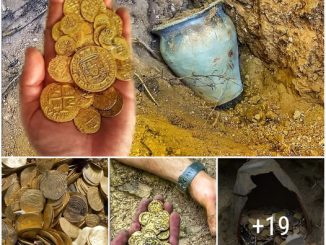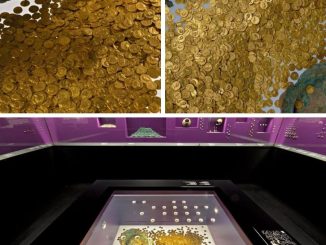History has a way of hiding its treasures in unexpected places, waiting patiently to be discovered by the curious hands of archaeologists. In 1911, beneath the floor of a Roman house in Corbridge, Northumberland, England, a remarkable find was made. Encased within a humble bronze jug lay a trove of 160 Aureus coins, dating back to the year 164 AD. These coins, with their gleaming gold surfaces, were carefully concealed by two bronze coins wedged in the neck of the jug, disguising their true value. What followed the lifting of this jug from the ground was a tale of revelation, as the weight of the gold broke through its confines, exposing the hidden wealth within. This remarkable discovery, lent by English Heritage, sheds light not only on the economic practices of ancient Rome but also on the intricate lives of those who once inhabited this Roman settlement. Join us on a journey through time as we delve into the archaeology behind the Aureus coins of Corbridge.

The Context of Corbridge
Corbridge, situated along the banks of the River Tyne, served as an important Roman town during the occupation of Britain. Its strategic location made it a bustling hub of commerce and trade, connecting the northern frontier of the empire with the rest of Britannia. The presence of military barracks, temples, and a thriving civilian population attests to the significance of Corbridge within the Roman administrative network.

The Discovery
In 1911, during excavations conducted by the Corbridge Excavation Fund, archaeologists stumbled upon a curious bronze jug buried beneath the ruins of a Roman dwelling. Little did they know that within this unassuming vessel lay a treasure trove of Aureus coins waiting to be unearthed. As the jug was lifted from its resting place, the weight of the gold proved too much for its fragile container, causing it to fracture and reveal the concealed riches within.

The Significance of Aureus Coins
Aureus coins were prized for their purity and value during the Roman era. Minted from solid gold, they served as a symbol of wealth and prestige. The discovery of such a substantial hoard of Aureus coins in Corbridge speaks volumes about the economic prosperity of the settlement and the financial activities of its inhabitants. It is likely that these coins were amassed through trade, taxation, or military service, offering insights into the economic dynamics of Roman Britain.

The Mystery of Concealment
The deliberate act of concealing the Aureus coins within the bronze jug raises intriguing questions about the motives of the individual or individuals responsible. Was it an attempt to safeguard their wealth during times of uncertainty? Or perhaps an act of ritualistic offering to the gods? The presence of the two bronze coins wedged in the neck of the jug suggests a conscious effort to disguise the true value of the hoard, hinting at a desire to keep it hidden from prying eyes.
Reflections on Roman Life
The discovery of the Aureus coins of Corbridge offers a rare glimpse into the everyday lives of the people who once called this Roman settlement home. It speaks of their aspirations, their fears, and their ingenuity in navigating the complexities of life in antiquity. Through the careful analysis of archaeological finds such as these, we are able to piece together the puzzle of the past and gain a deeper understanding of human history.

The story of the Aureus coins of Corbridge is not just a tale of buried treasure, but a testament to the enduring allure of archaeology. It reminds us of the power of discovery to transcend time and connect us with the lives of those who came before. As we marvel at the gleaming surfaces of these ancient coins, let us also reflect on the mysteries they hold and the stories they have yet to reveal. In the ever-evolving narrative of our past, each artifact unearthed is a precious piece of the puzzle, waiting to be uncovered and shared with the world.


